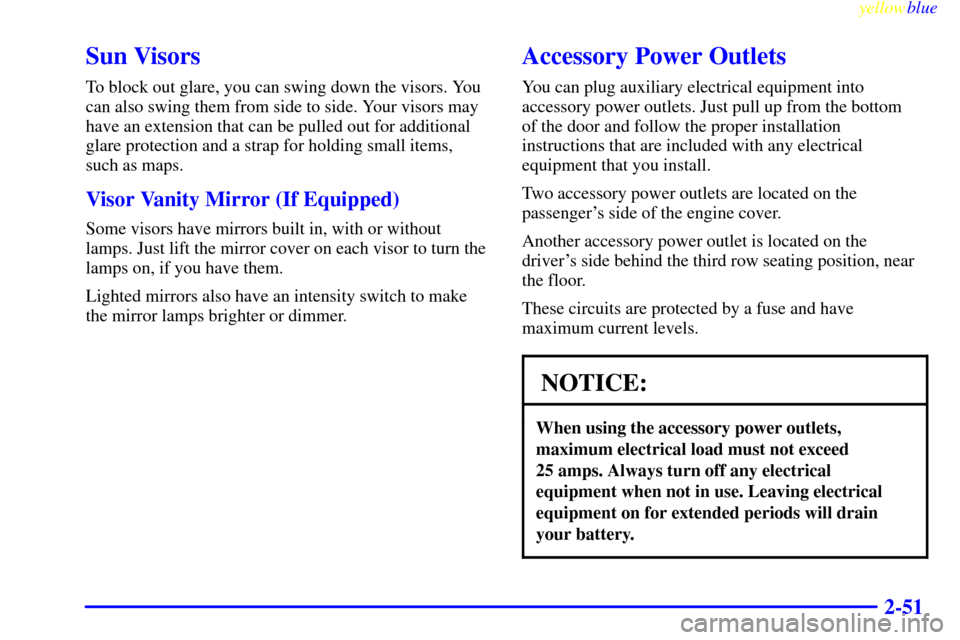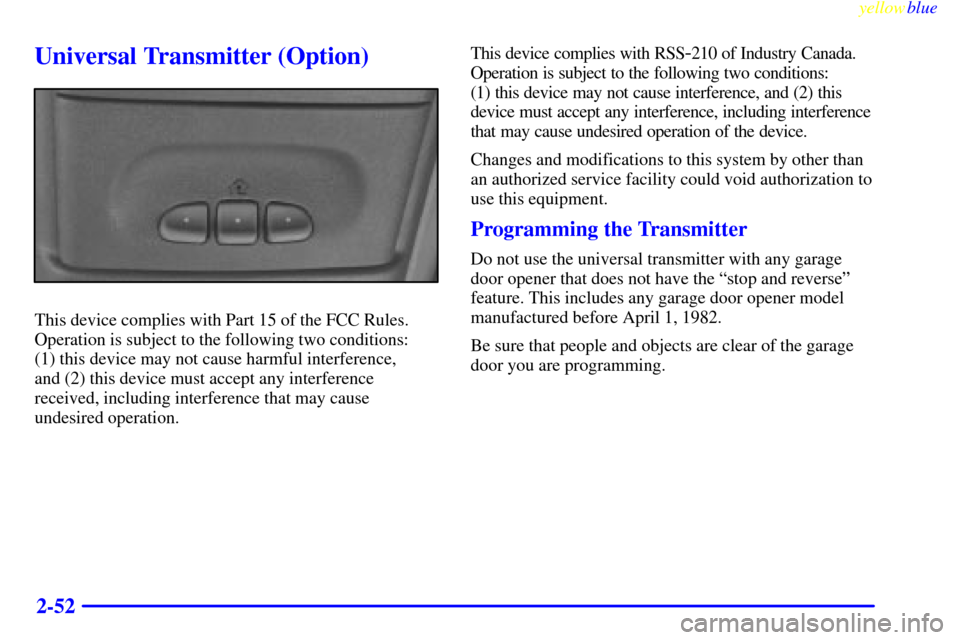CHEVROLET ASTRO PASSENGER 1999 2.G Owners Manual
Manufacturer: CHEVROLET, Model Year: 1999, Model line: ASTRO PASSENGER, Model: CHEVROLET ASTRO PASSENGER 1999 2.GPages: 392, PDF Size: 2.6 MB
Page 121 of 392

yellowblue
2-51
Sun Visors
To block out glare, you can swing down the visors. You
can also swing them from side to side. Your visors may
have an extension that can be pulled out for additional
glare protection and a strap for holding small items,
such as maps.
Visor Vanity Mirror (If Equipped)
Some visors have mirrors built in, with or without
lamps. Just lift the mirror cover on each visor to turn the
lamps on, if you have them.
Lighted mirrors also have an intensity switch to make
the mirror lamps brighter or dimmer.
Accessory Power Outlets
You can plug auxiliary electrical equipment into
accessory power outlets. Just pull up from the bottom
of the door and follow the proper installation
instructions that are included with any electrical
equipment that you install.
Two accessory power outlets are located on the
passenger's side of the engine cover.
Another accessory power outlet is located on the
driver's side behind the third row seating position, near
the floor.
These circuits are protected by a fuse and have
maximum current levels.
NOTICE:
When using the accessory power outlets,
maximum electrical load must not exceed
25 amps. Always turn off any electrical
equipment when not in use. Leaving electrical
equipment on for extended periods will drain
your battery.
Page 122 of 392

yellowblue
2-52
Universal Transmitter (Option)
This device complies with Part 15 of the FCC Rules.
Operation is subject to the following two conditions:
(1) this device may not cause harmful interference,
and (2) this device must accept any interference
received, including interference that may cause
undesired operation.This device complies with RSS
-210 of Industry Canada.
Operation is subject to the following two conditions:
(1) this device may not cause interference, and (2) this
device must accept any interference, including interference
that may cause undesired operation of the device.
Changes and modifications to this system by other than
an authorized service facility could void authorization to
use this equipment.
Programming the Transmitter
Do not use the universal transmitter with any garage
door opener that does not have the ªstop and reverseº
feature. This includes any garage door opener model
manufactured before April 1, 1982.
Be sure that people and objects are clear of the garage
door you are programming.
Page 123 of 392

yellowblue
2-53
Your vehicle's engine should be turned off while
programming the transmitter. Follow these steps to
program up to three channels:
1. If you have previously programmed a transmitter
channel, proceed to Step 2. Otherwise, hold down
the two outside buttons on the universal transmitter
until the indicator light begins to flash rapidly (after
20 seconds). Then release the buttons. This
procedure initializes the memory and erases any
previous settings for all three channels.
2. Decide which one of the three channels you want to
program. Hold the end of the hand
-held transmitter
about 2 to 5 inches (5 to 13 cm) away from the
surface of the universal transmitter so that you can
still see the indicator light.
3. Using both hands, press the hand
-held transmitter
button and the desired button on the universal
transmitter. Continue to press both buttons
through Step 4.
4. Hold down both buttons until you see the red light
on the universal transmitter flash rapidly. The rapid
flashing indicates that the universal transmitter has
been programmed. Release both buttons once the
light starts to flash rapidly.If you have trouble programming the universal
transmitter, make sure that you have followed the
directions exactly as described and that the battery in the
hand
-held transmitter is not dead. If you still cannot
program it, rotate the hand
-held transmitter end over end
and try again. The universal transmitter may not work
with older garage door openers that do not meet current
Federal Consumer Safety Standards. If you cannot
program the transmitter after repeated attempts, refer to
ªTraining a Garage Door Opener with Rolling Codesº
later in this section or contact the manufacturer of the
unit at 1
-800-355-3515.
Be sure to keep the original hand
-held transmitter
in case you need to erase and reprogram the
universal transmitter.
Note to Canadian Owners: During programming, the
hand
-held transmitter may automatically stop
transmitting after one or two seconds. In this case, you
should press and re
-press the button on the hand-held
transmitter every two seconds without ever releasing the
button on the universal transmitter. Release both buttons
when the indicator light on the universal transmitter
begins to flash rapidly.
Page 124 of 392

yellowblue
2-54 Operating the Transmitter
Press and hold the appropriate button on the universal
transmitter. The indicator light comes on while the
signal is being transmitted.
If the hand
-held transmitter appears to program the
universal transmitter but does not open your garage door,
and if the garage door opener was manufactured after
1996, the garage door opener may have a ªrolling codeº
system. A rolling code system changes the code of the
garage door opener every time you open or close the
garage door.
To determine if you have this system, press the button
on the universal transmitter that you have programmed
already. If the indicator light flashes rapidly for one to
two seconds, then turns solid, the garage door opener
has a rolling code system. In a rolling code system, the
garage door motor head unit must be trained to the
universal transmitter.
Training a Garage Door Opener with a
ªRolling Codeº Feature (If Equipped)
If you have not previously programmed the hand-held
transmitter to the universal transmitter, see
ªProgramming the Transmitterº listed previously. If you
have completed this programming already, you now
need to train the garage door opener motor head unit to
recognize the universal transmitter. Refer to your garage
door opener owner's manual for the proper transmitter
training procedure for your garage door opener brand.
1. Find the training button on the garage door opener
motor head unit. The exact location and color will
vary by garage door opener brand. If you have
difficulty finding the training button, refer to your
garage door opener owner's manual.
Page 125 of 392

yellowblue
2-55
2. Press the training button on the garage door
opener motor head unit. An indicator light will
begin to flash when the motor head unit enters the
training mode.
Note: Following this step, you have 30 seconds to
start Step 3.
3. Return to the universal transmitter in your vehicle
and firmly press and release the universal transmitter
button you have already programmed for two to
three seconds. Press and release the button again
(you may need to do this step up to three times) to
make sure that the universal transmitter has been
trained to the garage door opener motor head
unit. Check that the training was successful. The
motor head unit indicator light should no longer
be flashing.The garage door opener should now recognize the
universal transmitter. You may either use the universal
transmitter or the hand
-held transmitter to open the
garage door.
If after following these instructions, you still have
problems training the garage door opener, call the
manufacturer of the unit at 1
-800-355-3515.
Erasing Channels
To erase all three programmed channels, hold down the
two outside buttons until the indicator light begins to
flash (after 20 seconds). Release both buttons.
Accessories
Accessories for the universal transmitter are available
from the manufacturer of the unit. If you would like
additional information, please call 1
-800-355-3515.
Page 126 of 392

yellowblue
2-56
Instrument Panel
Page 127 of 392

yellowblue
2-57
A. Lamp Switches
B. Instrument Panel Dimmer
C. Multifunction Lever
D. Hazard Lamp Switch
E. Transmission Shift Lever
F. Ignition Switch
G. Rear Defogger (Option)
H. Comfort Controls
I. Rear A/C Control (Option)
J. Rear Heater Control (Option)K. Rear Washer/Wiper (Option)
L. Front Ashtray
M. Accessory Power Outlets
N. Cupholders/Storage Tray
O. Front Storage Compartment
P. Audio System
Q. Cigarette Lighter
R. Hood Release
S. Dome Override Button
Page 128 of 392

yellowblue
2-58
Instrument Panel Cluster
Your instrument panel cluster is designed to let you know at a glance how your vehicle is running. You'll know how
fast you're going, about how much fuel remains, and many other things you'll need to know to drive safely
and economically.
Page 129 of 392

yellowblue
2-59 Speedometer and Odometer
Your speedometer lets you see your speed in both miles
per hour (mph) and kilometers per hour (km/h). Your
odometer shows how far your vehicle has been driven,
in either miles (used in the United States) or kilometers
(used in Canada).
Your odometer is tamper resistant. The digital odometer
will read 999,999 if someone tries to turn it back.
You may wonder what happens if your vehicle needs a
new odometer installed. If the new one can be set to the
mileage total of the old odometer, then it must be. But if
it can't, then it's set at zero, and a label must be put on
the driver's door to show the old mileage reading when
the new odometer was installed.
Trip Odometer
The trip odometer can tell you how far your vehicle has
been driven since you last set the trip odometer to zero.
The trip odometer will appear in place of your regular
odometer when you press the TRIP button.
To reset the trip odometer, press and hold the TRIP
button. To change back to the regular odometer, press
the TRIP button again.
Warning Lights, Gages and Indicators
This part describes the warning lights and gages that
may be on your vehicle. The pictures will help you
locate them.
Warning lights and gages can signal that something is
wrong before it becomes serious enough to cause an
expensive repair or replacement. Paying attention to
your warning lights and gages could also save you or
others from injury.
Warning lights come on when there may be or is a
problem with one of your vehicle's functions. As you
will see in the details on the next few pages, some
warning lights come on briefly when you start the
engine just to let you know they're working. If you are
familiar with this section, you should not be alarmed
when this happens.
Gages can indicate when there may be or is a problem
with one of your vehicle's functions. Often gages and
warning lights work together to let you know when
there's a problem with your vehicle.
Page 130 of 392

yellowblue
2-60
When one of the warning lights comes on and stays on
when you are driving, or when one of the gages shows
there may be a problem, check the section that tells you
what to do about it. Please follow this manual's advice.
Waiting to do repairs can be costly
-- and even
dangerous. So please get to know your warning lights
and gages. They're a big help.
Safety Belt Reminder Light
When the key is turned to RUN or START, a tone will
come on for about eight seconds to remind people to
fasten their safety belts, unless the driver's safety belt is
already buckled.
The safety belt light will
also come on and stay on
for about 20 seconds, then
it will flash for about
55 seconds.
If the driver's belt is already buckled, neither the tone
nor the light will come on.
Air Bag Readiness Light
There is an air bag readiness light on the instrument
panel, which shows AIR BAG. The system checks the
air bag's electrical system for malfunctions. The light
tells you if there is an electrical problem. The system
check includes the air bag sensors, the air bag modules,
the wiring and the crash sensing and diagnostic module.
For more information on the air bag system, see ªAir
Bagº in the Index.
This light will come on
when you start your engine,
and it will flash for a few
seconds. Then the light
should go out. This means
the system is ready.
If the air bag readiness light stays on after you start the
engine or comes on when you are driving, your air bag
system may not work properly. Have your vehicle
serviced right away.
The air bag readiness light should flash for a few
seconds when you turn the ignition key to RUN. If the
light doesn't come on then, have it fixed so it will be
ready to warn you if there is a problem.